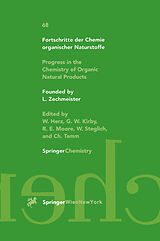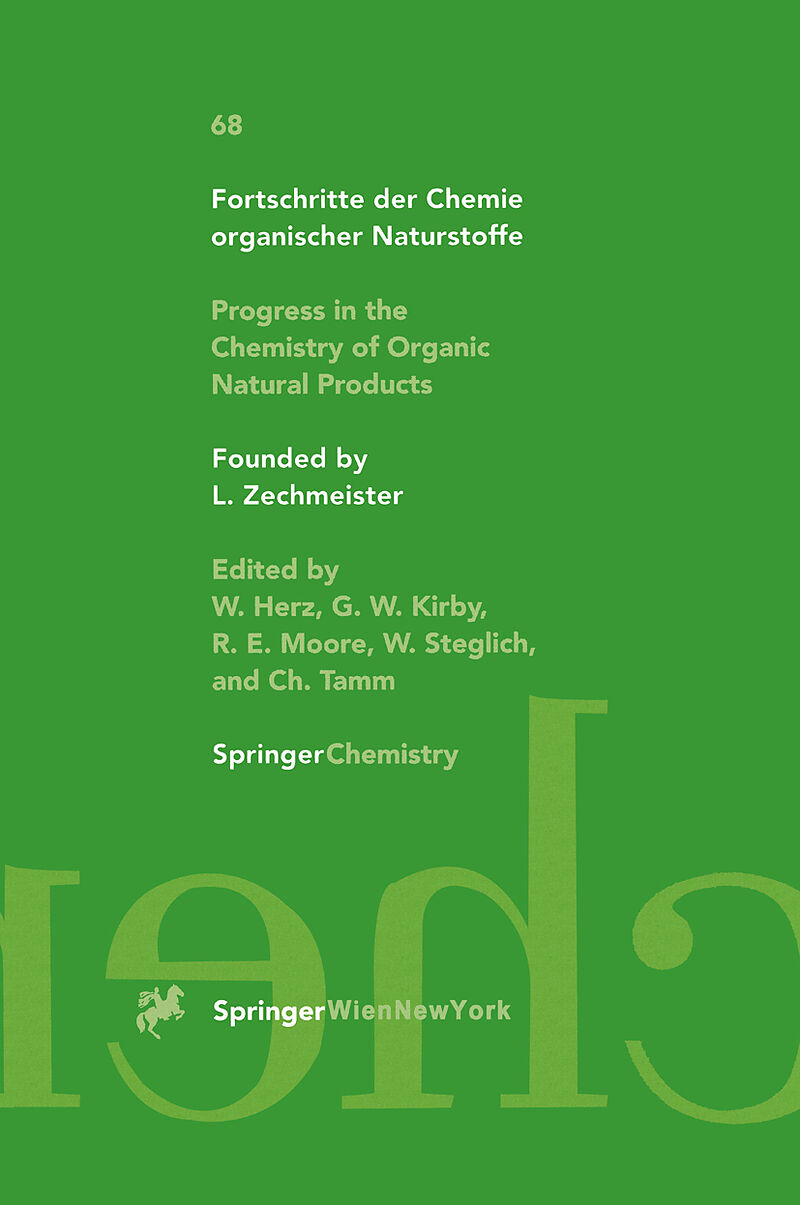Progress in the Chemistry of Organic Natural Products
Format:
E-Book (pdf)
EAN:
9783709168875
Genre:
Chemie
Herausgeber:
Springer Vienna
Anzahl Seiten:
498
Erscheinungsdatum:
06.12.2012
The objective of this ASI was to bring together specialists in several complex variables (many of whom have contributed to complex potential theory) and specialists in potential theory (all of whom have contributed to several complex variables) together with young researchers and graduate students for an interchange of ideas and techniques. Not only was the status of current research presented, but also the relevant background, much of which is not yet available in books. The following topics and interconnections among them were discussed: 1. Real and Complex Potential Theory. Capacity and approximation, basic prop erties of plurisubharmonic functions and methods to manipulate their singularities and study their growth, Green functions, Chebyshev-type quadratures, electrostatic fields and potentials, propagation of smallness. 2. Complex Dynamics. Review of complex dynamics in one variable, Julia sets, Fatou sets, background in several variables, Henon maps, ergodicity, use of potential theory and multifunctions. 3. Banach Algebras and Infinite Dimensional Holomorphy. Analytic multi functions, spectral theory, analytic functions on a Banach space, semigroups of holomor phic isometries, Pick interpolation on uniform algebras and Von Neumann inequalities for operators on a Hilbert space. The basic notion of complex potential theory is that of a plurisubharmonic function.
Inhalt
Naturally Occurring Organohalogen Compounds-A Comprehensive Survey.- 1. Introduction.- 2. Origins.- 3. Occurrence.- 3.1. Simple Alkanes.- 3.1.1. Chloromethane.- 3.1.2. Dichloromethane.- 3.1.3. Chloroform.- 3.1.4. Carbon Tetrachloride.- 3.1.5. Other Simple Haloalkanes.- 3.2. Simple Functionalized Acyclic Organohalogens.- 3.3. Simple Functionalized Cyclic Organohalogens.- 3.3.1. Cyclopentanes.- 3.3.2. Cyclitols and Benzoquinones.- 3.4. Terpenes.- 3.4.1. Monoterpenes.- 3.4.1.1. Acyclic Monoterpenes.- 3.4.1.2. Alicyclic Monoterpenes.- 3.4.2. Sesquiterpenes.- 3.4.2.1. Terrestrial Sesquiterpene Lactones.- 3.4.2.2. Indanone Sesquiterpenes.- 3.4.2.3. Other Terrestrial Sesquiterpenes.- 3.4.2.4. Marine Sesquiterpenes.- 3.4.2.4.1. Monocyclic and Other Simple Sesquiterpenes.- 3.4.2.4.2. Chamigrene and Related Types.- 3.4.2.4.3. Eudesmane and Other Types.- 3.4.2.4.4. Cuparene, Laurene, and Other Aromatic Types.- 3.4.3 Diterpenes.- 3.4.3.1 Terrestrial Diterpenes.- 3.4.3.2. Marine Diterpenes.- 3.4.3.2.1. Diterpenes of Aplysia.- 3.4.3.2.2. Diterpenes of Laurencia.- 3.4.3.2.3. Sphaerococcus and Other Red Algae Diterpenes.- 3.4.3.2.4. Sponge Diterpenes.- 3.4.3.2.5. Gorgonian Diterpenes.- 3.4.4. Higher Terpenes.- 3.5. Steroids.- 3.6. Marine Nonterpenes-C15 Acetogenins.- 3.7. Iridoids.- 3.8. Lipids and Fatty Acids.- 3.9. Fluorine-Containing Carboxylic Acids.- 3.10. Prostaglandins.- 3.11. Furanones.- 3.12. Amino Acids and Peptides.- 3.13. Alkaloids.- 3.14. Heterocycles.- 3.14.1. Pyrroles.- 3.14.2. Indoles.- 3.14.3. Carbazoles.- 3.14.4. Indolocarbazoles.- 3.14.5. Carbolines.- 3.14.6. Quinolines and Other Nitrogen Heterocycles.- 3.14.7. Benzofurans and Related Compounds.- 3.14.8. Pyrones.- 3.14.9. Coumarins and Isocoumarins.- 3.14.10. Flavones and Isoflavones.- 3.15. Polyacetylenes.- 3.15.1. Terrestrial Polyacetylenes and Derived Thiophenes.- 3.15.2. Marine Polyacetylenes.- 3.16. Enediynes.- 3.17. Macrolides.- 3.18. Naphthoquinones and Higher Quinones.- 3.19. Tetracyclines.- 3.20. Aromatics.- 3.21. Simple Phenols.- 3.21.1. Terrestrial.- 3.21.2. Marine.- 3.22. Complex Phenols.- 3.22.1. Diphenylmethanes and Related Compounds.- 3.22.2. Diphenyl Ethers and Related Compounds.- 3.22.3. Tyrosines.- 3.22.3.1. Simple Tyrosines, Thyroxine, and Related Compounds.- 3.22.3.2. Transformed Single Tyrosines.- 3.22.3.3. Transformed Multiple Tyrosines.- 3.22.3.4. Bastadins.- 3.22.4. Depsides.- 3.22.5. Depsidones.- 3.22.6. Xanthones.- 3.22.7. Anthraquinones and Related Compounds.- 3.22.8. Griseofulvin and Related Compounds.- 3.22.9. Miscellaneous Fungal Metabolites and Other Complex Phenols.- 3.23. Glycopeptides.- 3.24. Orthosomycins.- 3.25. Dioxins.- 3.26. Humic Acids.- 4. Biohalogenation.- 4.1. Introduction and Early Examples.- 4.2. Chloroperoxidase.- 4.3. Bromoperoxidase.- 4.4. Other Peroxidases.- 5. Biodegradation.- 6. Natural Function.- 7. Significance.- 8. Future Outlook.- Addendum.- Acknowledgements.- References.- Author Index.

Leider konnten wir für diesen Artikel keine Preise ermitteln ...
billigbuch.ch sucht jetzt für Sie die besten Angebote ...
Die aktuellen Verkaufspreise von 3 Onlineshops werden in Realtime abgefragt.
Sie können das gewünschte Produkt anschliessend direkt beim Anbieter Ihrer Wahl bestellen.
Loading...
Die aktuellen Verkaufspreise von 3 Onlineshops werden in Realtime abgefragt.
Sie können das gewünschte Produkt anschliessend direkt beim Anbieter Ihrer Wahl bestellen.
| # | Onlineshop | Preis CHF | Versand CHF | Total CHF | ||
|---|---|---|---|---|---|---|
| 1 | Seller | 0.00 | 0.00 | 0.00 |
